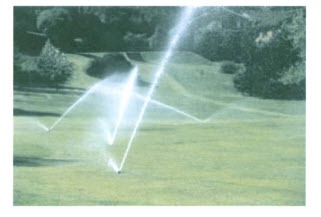Case study 3: Variable speed drives on golf course irrigation pumps
Case study summary
More effective irrigation was achieved while saving water, electricity, maintenance and man hours over the manual and fixed speed systems.
Other potential applications
Any applications which requires fixed pressure or fixed flow rate, even though the pipe system changes and varies the friction or static head losses.
Problems with fixed speed irrigation systems
Output requirements vary when different parts of the sprinkler system are in use. Control valves are often used to maintain pressure or regulate flow, with inevitable wastage of energy.
There can be excessive usage of water and uneven application.
Pressure surges, caused by on-off control with long pipe runs, lead to burst pipes.
Benefit of using variable speed pumping
Three different golf courses all reported a successful outcome with VSD pumps, but emphasized different benefits.
A golf club in the London area retrofitted 7.5 kW VFDs to existing fixed speed pumps, each with pressure transmitter and flow meter. The pressure transmitter sends information on water pressure to the drive, which adjusts the speed of the motors to maintain the correct water flow to keep the grass healthy and avoid waterlogging. This keeps the use of both water and power to minimum and the flow meter helps the club to keep track of its water. Maintenance costs are also kept low as wear and tear on pumps is reduced.
The system controls 450 pop-up sprinklers in three zones, each zone with its own pump. The control panel can be set to operate sprinklers in several combinations and for varying times, ensuring that the turf get the correct amount of water.
The automatic watering has not only improved the condition of the fairways but also saves two days work over the manual method. The system also allows fertilizer to be watered-in in spring and keeps the ground in the best condition for spiking equipment to work most effectively without pulling out lumps of turf and being damaged itself on hard unwatered ground.
A Southern Californian golf course replaced fixed speed equipment, comprising three 55 kW (75 hp) pumps and one 30 kW (40 hp) jockey pump, with three 45 kW (60 hp} and one 4 kW (5 hp) jockey pump.
This avoided up to four line breaks a day by eliminating the pressure surges.
Annual electricity cost was reduced by 46% (€/$ 25 000).
A rebate from the power company of $ 100 for every VFD hp was granted.
Computer control with flow and pressure measurement allows precise pressure control for specific irrigation tasks and better management decisions. This is important with the area’s water shortage.
A golf course in the Palm Springs area of California replaced three 90 kW (125 hp) pumps, one 55 kW (75 hp} pump and one 22 kW (30 hp) jockey pump, with three 55 kW (75 hp) pumps, one 30 kW (40 hp) pump and one 5.5 kW (7.5 hp) jockey pump, thus almost halving the pumping power. All replacement pumps were variable speed .
Typically there is a 100 000 kWh saving per month, which with an energy cost of €/$ 0.09/kWh corresponds to a €/$ 9000 cost saving. This represents between 30 and 50%.
A rebate of €/$ 6000 was obtained from the power company for use of VFDs.
Pump and motor life were improved and control valve maintenance eliminated .

